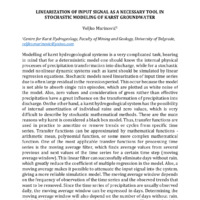Linearization of Input Signal as a Necessary Tool in Stochastic Modeling of Karst Groundwater
Објеката
- Тип
- Саопштење са скупа штампано у изводу
- Верзија рада
- објављена
- Језик
- енглески
- Креатор
- Veljko Marinović
- Извор
- Karst: From Top to Bottom, Belgrade, 6.6.2021.
- Уредник
- Zoran Stevanović, Saša Milanović
- Издавач
- Belgrade : Centre for Karst Hydrogeology
- Датум издавања
- 2021
- Сажетак
- Modelling of karst hydrogeological systems is a very complicated task, bearing in mind that for a deterministic model one should know the internal physical processes of precipitation transformation into discharge, while for a stochastic model nonlinear dynamic systems such as karst should be simulated by linear regression equations. Stochastic models need linearization of input time series due to often large residual in the recession period. This occur because the model is not able to absorb single rain episodes, which are plotted as white noise of the model. Also, zero values and consideration of gross rather than effective precipitation have a great influence on the transformation of precipitation into discharge. On the other hand, a karst hydrogeological system has the possibility of internal amortization of individual rains and zero values, which is very difficult to describe by stochastic mathematical methods. These are the main reasons why karst is considered a black box model. Thus, transfer functions are used in practice to amortize or remove trends or cycles from specific time series. Transfer functions can be approximated by mathematical functions - arithmetic mean, polynomial function, or some more complex mathematical function. One of the most applicable transfer functions for processing time series is the moving average filter, which finds average values from several previous and next values of the time series for a certain time step (moving average window). This linear filter can successfully eliminate days without rain, which greatly reduce the coefficient of multiple regression in the model. Also, a moving average makes it possible to attenuate the input signal into the system, giving a more reliable simulation model. The moving average window depends on the frequency of observation of the time series and the observed trends that want to be removed. Since the time series of precipitation are usually observed daily, the moving average window can be expressed in days. Determining the moving average window will also depend on the number of days without rain, which should be completely removed from the time series. The example of the Seljašnica karst spring, for which a stochastic model with filtered and unfiltered precipitation was made, clearly indicates the necessity of linearization of the input signal, since the residues in the recession period are much smaller if transformed precipitation is used in the model.
- почетак странице
- 27
- крај странице
- 28
- isbn
- 978-86-7352-369-9
- Subject
- karstne podzemne vode, stohastičko modeliranje, transfer funkcije, pokretni prosek
- karst groundwater, stochastic modelling, transfer function, moving average
- Шира категорија рада
- М30
- Ужа категорија рада
- М34
- Права
- Отворени приступ
- Лиценца
- Creative Commons – Attribution-NonComercial-Share Alike 4.0 International
- Формат
Veljko Marinović. "Linearization of Input Signal as a Necessary Tool in Stochastic Modeling of Karst Groundwater" in Karst: From Top to Bottom, Belgrade, 6.6.2021., Belgrade : Centre for Karst Hydrogeology (2021)
This item was submitted on 23. децембар 2021. by [anonymous user] using the form “Рад у зборнику радова” on the site “Радови”: http://dr.rgf.bg.ac.rs/s/repo
Click here to view the collected data.
